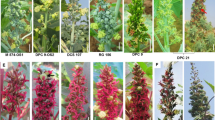Summary
Results indicated that gynoecious stability in the F1 is governed by partial dominance. The degree of gynoecious stability is dependent upon genotypes, stages of plant for AgNO3 application and number of sprays. Depending upon the genotypes, the one-true-leaf stage and one spray of 250 ppm AgNO3 showed more gynoecious stability in the F1. Twice application of AgNO3 at the two-true-leaf stage produced the maximum number of male flowers. Plants exposed to light for longer time (10.00 h) after AgNO3 application produced less flowers than when exposed for shorter time (15.00 and 20.00 h).
Similar content being viewed by others
References
Beyer, E.Jr. 1976. Silver ion: A potent antiethylene agent in cucumber and tomato. Hort. Sci. 11 (3): 195–196.
Galun, E. & D., Atsmon, 1960. The leaf floral bud relationship of genetic sexual types in the cucumber plants. Bull. Israel Research Council 9D (1): 43–50.
Hsiao, C. H., 1981. The inheritance and breeding of stability of gynoecious sex expression in cucumbers (Cucumis sativus L.) Ph. D. thesis, Cornell University, Ithaca, N. Y. 14853, USA.
Kalloo & S., Franken, 1978. Chemical induction of staminate flowers in four determinate gynoecious lines of pickling cucumber. Gartenbauwissenschaft 43 (6): 280–282.
Munger, H. M., 1979. A summary of cucumber released from Cornell breeding program. Vegetable Improvement Newsletter 21: 3–4.
Nijs, A. P. M.den & D. L., Visser, 1980. Induction of male flowering in gynoecious cucumbers. (Cucumis sativus L.) by silver ion. Euphytica 29: 273–280.
Owens, K. W., G. E., Tolla & C. E., Peterson, 1980. Induction of staminate flowers on gynoecious cucumber by aminoethoxyvinylglycine. Hort. Sci. 15 (3): 256–257.
Peterson, C. E. & L. D., Anhder, 1960. Induction of staminate flowers on gynoecious cucumber with gibberellin A3. Science 131: 1673–1674.
Ponti, O. M. B.de & Y. O., Kho, 1977. Induction of male flowering in cucumber and gherkin by means of silver nitrate: an alternative to gibberellic acid. Zaadbelangen 31 (2): 53–57.
Snedecor, G. W. & W. G., Cochran, 1967. Statistical methods. The Iowa State University Press, Ames, Iowa, USA.
Tolla, G. E. & C. E., Peterson, 1979. Comparison of gibberellin A4/A7 and silver-nitrate for induction of staminate flowers in a gynoecious cucumber line (Cucumis sativus L.). Hort. Sci. 14 (4): 542–544.
Author information
Authors and Affiliations
Additional information
Present address: Division of Vegetable Crops, Indian Agricultural Research Institute, New Delhi-110012, India.
Rights and permissions
About this article
Cite this article
More, T.A., Munger, H.M. Gynoecious sex expression and stability in cucumber (Cucumis sativus L.). Euphytica 35, 899–903 (1986). https://doi.org/10.1007/BF00028598
Received:
Issue Date:
DOI: https://doi.org/10.1007/BF00028598




